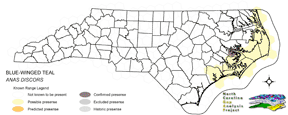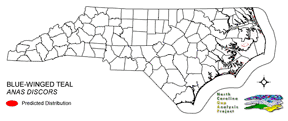
| Taxa: |
| Order: |
| Family: |
| Aves |
| Anseriformes |
| Anatidae |
| NatureServe Global Rank: |
| NatureServe State (NC) Rank: |
| G5 |
| S1B,S2N |
| Federal Status: |
| NC State Status: |
| --- |
| W2 |


| Land Unit |
| US Fish & Wildlife Service |
| US Forest Service |
| US National Park Service |
| US Department of Defense |
| NC State Parks |
| NC University System |
| NC Wildlife Res. Com. |
| NC Forest Service |
| NC Div. of Coastal Mgmt. |
| Local Governments |
| Non-Governmental Org. |
| Other Public Lands |
| Private Lands |
| GAP Status 1-2 |
| All Protected Lands |
| Statewide |
| Hectares |
| 3,844.89 |
| 232.65 |
| 1,657.98 |
| 2,205.18 |
| 105.93 |
| 2.79 |
| 704.52 |
| 0.00 |
| 236.43 |
| 1.26 |
| 246.42 |
| 4.23 |
| 20,465.55 |
| 6,497.91 |
| 9,242.19 |
| 29,707.83 |
| Acres |
| 9,500.93 |
| 574.89 |
| 4,096.96 |
| 5,449.12 |
| 261.76 |
| 6.89 |
| 1,740.91 |
| 0.00 |
| 584.23 |
| 3.11 |
| 608.92 |
| 10.45 |
| 50,571.47 |
| 16,056.68 |
| 22,837.94 |
| 73,409.63 |
| % of Dist. on |
| Prot. Lands |
| 41.6 % |
| 2.5 % |
| 17.9 % |
| 23.9 % |
| 1.1 % |
| < 0.1 % |
| 7.6 % |
| 0.0 % |
| 2.6 % |
| 2.7 % |
| 2.7 % |
| < 0.1 % |
| 0.0 % |
| 70.3 % |
| ----- |
| ----- |
| % of Dist. on |
| All Lands |
| 12.9 % |
| 0.8 % |
| 5.6 % |
| 7.4 % |
| 0.4 % |
| < 0.1 % |
| 2.4 % |
| 0.0 % |
| 0.8 % |
| < 0.1 % |
| 0.8 % |
| < 0.1 % |
| 68.9 % |
| 21.9 % |
| ----- |
| ----- |
|
Occasionally breeds on Pea Island, Cape Romain, and in Onslow and Pamlico Counties (Potter et al. 1980); rarely in the coastal plain (Fussell 1994) and mountains (Simpson 1992). Open areas such as hayfields, or coastal meadows with fresh or brackish ponds, marshes (Kaufman 1996), or impoundments (Fussell 1994). Also the borders of sloughs, swamps, small ponds, wet fields, cattail marshes, lakeshores (Harrison 1975), and slow-moving streams (Ehrlich et al. 1988). Nest cover may be more important than the presence of water (McHenry 1971). Can be loosely colonial (Harrison 1975). Ducklings are reared in ponds or sloughs with plentiful emergent vegetation (Nicholson 1997), which can be at a distance from the nest site (Bellrose 1976). Nest is generally built near water, but may be far from it (Bellrose 1976). It is placed in a depression on damp (Ehrlich et al. 1988) or dry ground where it is surrounded by vegetation (Harrison 1975), preferably grass (Bellrose 1976). Will also nest atop muskrat dens (Harrison 1975). NATURE SERVE GLOBAL HABITAT COMMENTS: Marshes, ponds, sloughs, lakes, and sluggish streams. In migration and when not breeding, in both freshwater and brackish situations (AOU 1983); prefers freshwater marshes, ponds, and sloughs, but occurs also in river pools, salt ponds, coastal lagoons, estuaries, and flooded pastures (Costa Rica, Stiles and Skutch 1989; Gammonley and Fredrickson 1995). Commonly colonizes newly available habitats. Optimal nesting habitats include semi-permanent wetlands, ponds, and seasonal wetlands surrounded by grassland (Brewer et al. 1991). Nests usually on the ground among tall grasses or sedges, usually near water; seems to prefer to nest in native grass comunities in good range condition (Gammonley and Fredrickson 1995). Nest cover is provided by matted residual herbaceous vegetation (Gammonley and Fredrickson 1995). In the Midwest, bluegrass is the preferred nesting cover; also commonly uses hayfields and sedge meadows within 100 m of water (Brewer et al. 1991). Broods often use semi-permanent wetlands that include about 50% open water and a good supply of aquatic insects and other invertebrates (Brewer et al. 1991). Stock ponds with well-developed emergent vegetation provide locally important brood habitat (Gammonley and Fredrickson 1995). Females change breeding sites from year to year in response to changes in wetland condtitions (Gammonley and Fredrickson 1995). Male breeding territories include one or two small ponds within the home range (Gammonley and Fredrickson 1995). |
| Code | Name | Description | NC Natural Heritage Program Equivalent |
| 3 | Tidal Marsh | Fresh and brackish tidal marshes, including cord grass, wild rice, sawgrass and needlerush alliances. | Brackish Marsh, Interdune pond, Maritime wet grassland |
| 124 | Maritime Scrubs and Tidal Shrublands | Coastal shrubs including wax-myrtle, swamp rose, alder, yaupon, and greenbriar. | Maritime Shrubs, Salt Shrub |
| 372 | Interdune Herbaceous Wetlands | Dune swales with permanently flooded to intermittently exposed hydrology. Species composition depends on salinity and can include cut grass, spike-rush, mosquito fern, and hornwort. | Interdune Pond, Maritime Wet Grasslands |
| 371 | Maritime Grasslands | Dune grass community consisting of sea oats and beach grasses. | Dune grass, Maritime dry grassland |
| 380 | Coastal Plain Fresh Water Emergent | Emergent vegetation in fresh water seepage bogs, ponds and riverbeds of the coastal plain. Includes alliances dominated by sedges, eelgrass, as well as cane found in unforested cane-brakes. | Small Depression Pond, Sandhill Seep, Floodplain Pool, Unforested Floodplain Canebrake, Riverscour Prairies, Vernal Pools |
| 173 | Coastal Plain Riverbank Shrubs | Shrub dominated riverbanks, commonly dominated by willows and/or alders. | Sand and Mud Bar |
| 205 | Agricultural Pasture/Hay and Natural Herbaceous | Farm fields used for pasture grass or hay production, as well as old fields dominated by native and exotic grasses. | No equivalent |
| 8 | Open water | Open water without aquatic vegetation. | No equivalent |
|
Gammonley, J. H., and L. H. Fredrickson. 1995. Life history and management of the blue-winged teal. USDI National Biological Service, Waterfowl Management Handbook 13.1.8. 7 pp.
U.S. Fish and Wildlife Service. 22 July 1996. Migratory bird hunting; proposed frameworks for early-season migratory bird hunting regulations. Federal Register 61(141):37994-38011. Bennett, L.J. 1938. The blue-winged teal:its ecology and management. Ames, Iowa. 144pp. Simpson MB Jr. 1992. Birds of the Blue Ridge Mountains. Chapel Hill and London: University of North Carolina Press. Fussell, J.O. III. 1994. A birder’s guide to coastal North Carolina. Chapel Hill and London: The University of North Carolina Press. Kaufman K. 1996. Lives of North American Birds. Boston, New York: Houghton Mifflin Company. Nicholson CP. 1997. Atlas of the breeding birds of Tennessee. Knoxville: University of Tennessee Press. McHenry, M.G. 1971. Breeding and post-breeding movements of blue-winged teal (Anas discors) in southwestern Manitoba. Ph.D. Thesis, University of Oklahoma, Norman. 67 p. Barker, W. T., et al. 1990. Effects of specialized grazing systems on waterfowl production in southcentral North Dakota. Trans. 55th North American Wildl. & Nat. Res. Conf., pp. 462-474. Harrison, H.H. 1975. A field guide to bird's nests in the U.S. east of the Mississippi River. Houghton Mifflin Company, Boston, Massachusetts. 257 p. Bellrose, F.C. 1976. Ducks, geese and swans of NorthšAmerica. Stackpole Books, Harrisburg, Pa. Paton, P. W. C., A. Taylor, and P. R. Ashman. 1984. Blue- winged teal nesting in Hawaii. Condor 86:219. Harrison, C. 1978. A field guide to the nests, eggs and nestlings of North American birds. Collins, Cleveland, Ohio. Harrison, H.H. 1979. A field guide to western birds' nests. Houghton Mifflin Company, Boston. 279 pp. Potter, E. F., J. F. Parnell, and R. P. Teulings. 1980. Birds of the Carolinas. Univ. North Carolina Press, Chapel Hill. 408 pp. Terres, J.K. 1980. The Audubon Society encyclopedia of North American birds. Alfred A. Knopf, New York. American Ornithologists' Union (AOU), Committee on Classification and Nomenclature. 1983. Check-list of North American Birds. Sixth Edition. American Ornithologists' Union, Allen Press, Inc., Lawrence, Kansas. Raffaele, H.A. 1983. A guide to the birds of Puerto Rico and the Virgin Islands. Fondo Educativo Interamericano, San Juan, Puerto Rico. 255 pp. Hilty, S.L., and W.L. Brown. 1986. A guide to the birds of Colombia. Princeton University Press, Princeton, New Jersey. 836 pp. Marcy, L. E. 1986. Waterfowl nest baskets. Section 5.1.3, US Army Corps of Engineers Wildlife Resources Management Manual. Tech. Rep. EL-86-15. Waterways Expt. Station, Vicksburg, Mississippi. 16 pp. Ehrlich, P.R., D.S. Dobkin, and D. Wheye. 1988. The birder's handbook:a field guide to the natural history of North American birds. Simon and Shuster, Inc., New York. xxx + 785 pp. Root, T. 1988. Atlas of wintering North American birds:An analysis of Christmas Bird Count data. University of Chicago Press. 336 pp. Stiles, F.G., and A.F. Skutch. 1989. A guide to the birds of Costa Rica. Comstock Publ. Associates, Cornell University Press, Ithaca, New York. 511 pp. Jackson, G. D. 1991. Field identification of teal in North America:female-like plumages. Part I:blue-winged, cinnamon, and green-winged teal. Birding 23(3):124-133. Brewer, R., G.A. McPeek, and R.J. Adams, Jr. 1991. The Atlas of Breeding Birds of Michigan. Michigan State University Press, East Lansing, Michigan. xvii + 594 pp. Livezey, B. C. 1991. A phylogenetic analysis and classification of recent dabbling ducks (tribe Anatini) based on comparative morphology. Auk 108:471-507. |
For more information please contact them at:
NC-GAP Analysis Project
Dept. of Zoology, NCSU
Campus Box 7617
Raleigh, NC 27695-7617
(919) 513-2853
www.basic.ncsu.edu/ncgap